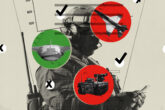February 26, 2020
How Adversarial Attacks Could Destabilize Military AI Systems
Artificial intelligence and robotic technologies with semi-autonomous learning, reasoning, and decision-making capabilities are increasingly being incorporated into defense, military, and security systems. Unsurprisingly, there is increasing concern about the stability and safety of these systems. In a different sector, runaway interactions between autonomous trading systems in financial markets have produced a series of stock market “flash crashes,” and as a result, those markets now have rules to prevent such interactions from having a significant impact.
Could the same kinds of unexpected interactions and feedback loops lead to similar instability with defense or security AIs?
Read the full article from IEEE Spectrum.
Learn more about the Artificial Intelligence and International Stability Project:

Artificial Intelligence and International Stability Project
Despite calls from prominent scientists to avoid militarizing AI, nation-states are already using AI and machine-learning tools for national security purposes. AI has the pote...
Read MoreMore from CNAS
-
Technology & National Security
Promethean RivalryExecutive Summary Just as nuclear weapons revolutionized 20th-century geopolitics, artificial intelligence (AI) is primed to transform 21st-century power dynamics—with world l...
By Bill Drexel
-
Defense / Technology & National Security
Safe and EffectiveThe promise of artificial intelligence (AI) and autonomy to change the character of war inches closer to reality...
By Josh Wallin
-
Technology & National Security
Catalyzing CrisisThe arrival of ChatGPT in November 2022 initiated both great excitement and fear around the world about the potential and risks of artificial intelligence (AI). In response, s...
By Bill Drexel & Caleb Withers
-
Technology & National Security
Obstacles and Opportunities for Transformative ChangeWatch:...
By Paul Scharre




